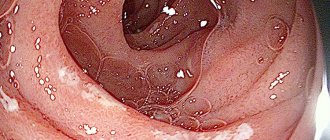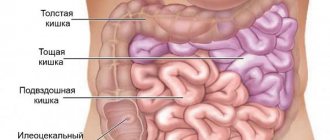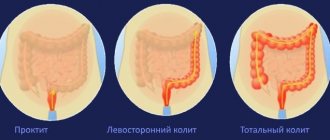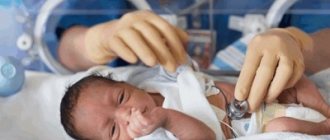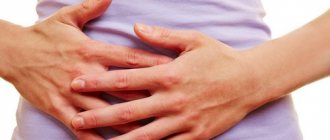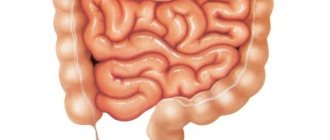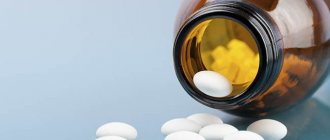Definition, prevalence and classification
In healthy people, the sigmoid colon has an average length of 54 cm. If its size is increased, experts speak of dolichosigma. The pathology is diagnosed in 25-40% of children suffering from chronic constipation. In general, the incidence of dolichosigma is 1 case per 500 people. Depending on the severity of symptoms, there are 3 forms of dolichosigma:
- Compensated. In this case, the symptoms are mild. Sometimes stool retention occurs, but not more than four to five days. Pain in the abdomen is periodically bothersome, but the patient’s general condition remains normal. Sometimes laxatives or an enema are required.
- Subcompensated. There is frequent constipation, flatulence, and increased abdominal pain. Laxatives do not give the desired effect, an enema is necessary.
- Decompensated. Constipation is constant, a person cannot cleanse his intestines for a week or more. Due to intestinal obstruction, abdominal pain and flatulence occur, and signs of intoxication develop due to the accumulation of gases and feces. In some cases, surgical treatment is necessary.
Traditional treatment of colon diseases
Due to the great importance of nutrition in the treatment of the disease, the use of traditional recipes helps improve the condition of patients at the initial stage of the disease. The main tasks of eliminating diarrhea, constipation, relieving inflammation, and improving motor skills are solved by using traditional medicinal recipes.
In the treatment of colitis associated with inflammation of the mucous membrane, oat infusion obtained by boiling oatmeal in water, as well as drinking raspberry infusion before meals, helps well.
To remove worms and infections, enemas from garlic infusion are used, with the use of onions after the procedure. Ingestion of brewed wormwood helps prevent pinworms.
An effective remedy for getting rid of dysbacteriosis is to use propolis tincture and cinquefoil herb. Oak bark tea helps stop diarrhea.
Disorders associated with constipation are treated by consuming a mixture of prunes, figs and dried apricots. Melissa and ginger root, brewed in boiling water, help get rid of flatulence. For intestinal spasms, a mixture of valerian root and fennel fruit works well.
Important! Before using folk remedies, you should discuss the dosage and frequency of their use with your doctor.
Correcting your diet is one of the main steps in treating colon diseases. For a long period of time, it is necessary to reduce the amount of meat and exclude white bread from the diet. An excellent effect comes from daily consumption of fresh fruits and vegetables, herbs, seafood, fish, and dairy products.
Causes
The pathology can be congenital or acquired. Usually the first option is diagnosed in children in the first years of life. The causes of congenital dolichosigma are as follows:
- hereditary predisposition;
- taking certain groups of medications during pregnancy;
- infectious diseases during pregnancy;
- unfavorable environmental situation, radiation.
The acquired form usually develops in people after 40 years of age. Provoking factors: excessive consumption of meat and baked goods, a sedentary lifestyle, digestive disorders (for example, putrefactive dyspepsia) or diseases of the gastrointestinal tract (ulcers and erosions of the mucous membrane, polyps, etc.).
Frequent constipation is the main symptom of dolichosigma Photo: shutterstock.com
Determination of intestinal motility
What is intestinal peristalsis? Have you ever wondered what happens in the body with any food a person eats? First, it enters the stomach, where it is digested using hydrochloric acid produced by the mucous membrane and turns into the so-called food bolus. At the last stage, this same lump moves into the rectum through wave-like contractions of the intestine.
It is these movements that are called peristalsis. In the walls of the intestine there are smooth muscles located in two layers, perpendicular to each other. Their coordinated contractions form a “wave” that brings the food bolus to the anus. The speed of its movement can be completely different depending on the circumstances. For example, along the small intestine the lump moves either very slowly, or, on the contrary, very quickly. This mainly depends on the characteristics of the food consumed. In the colon, wave-like contractions slow down, but powerful movements occur several times during the day, which help move the lump towards the outlet.
Peristalsis occurs immediately after any food enters the gastrointestinal tract. The frequency of smooth muscle contractions depends on the specific part of the intestine and can be:
- up to 3 within a minute in the rectum;
- 3 or 4 contractions per minute in the large intestine;
- 9-10 in the small intestine;
- about ten contractions in the duodenum.
When smooth muscle function slows down, serious problems with bowel movements (constipation) arise, and metabolism also deteriorates. Because of this, the entire body suffers. First, weakness and a feeling of constant fatigue appear, and then any diseases of the digestive tract and other organs may develop.
Symptoms
Their severity depends on the form of the disease. For some people, symptoms are minor and do not affect quality of life. In such cases, elongation of the sigmoid colon is diagnosed by chance. For example, during colonoscopy or irrigoscopy performed for another purpose.
In other patients, the signs of dolichosigma are as follows:
- Abdominal pain. It often does not have a clear localization; the longer the stool retention lasts, the stronger the pain.
- Retention of stool. At the initial stages, bowel movements occur less than three times a week, and as the pathology develops, even less frequently. Sometimes a person cannot go to the toilet for more than ten days.
- Intoxication. Manifested by decreased appetite, general weakness, nausea, and sometimes vomiting.
- Flatulence. Caused by retention of gases in the intestines and slower movement of feces.
In children, in addition to the above symptoms, lethargy, tearfulness, and sudden changes in mood occur. The child eats poorly or refuses to eat at all. As a result, anemia and hypovitaminosis develop, and physical development is delayed.
Treatment
Therapy for dolichosigma must be comprehensive. It includes the following activities:
- diet;
- drug treatment, including laxatives;
- physiotherapy.
Operations for dolichosigma are rarely performed. They are indicated in cases of prolonged constipation, even against the background of conservative therapy, with the formation of fecal stones, severe pain, intestinal perforation or obstruction.
Diet therapy
The diet is aimed at preventing constipation and stimulating bowel function.
Foods high in fiber (vegetables, fruits, nuts, bran) and vegetable oils, such as olive, are beneficial. They contribute to the formation and movement of feces and stimulate peristalsis. At the same time, you need to limit foods that slow down the intestines: starch-rich vegetables (potatoes, bananas), flour products, rice and semolina. The list of “useful” and “harmful” foods for dolichosigma is given in the table.
To prevent constipation, it is useful to include wheat bran in your diet. They are pre-soaked for 15-20 minutes. Then add to salads, vegetable dishes, cutlets. Adults can take 1 teaspoon 3-4 times a day. The amount of bran is gradually increased and brought to 6 teaspoons per day. At the same time, it is necessary to take a sufficient amount of fluid, at least 2 liters per day.
Medicines
They are prescribed mainly to normalize intestinal function and reduce the severity of symptoms. Since constipation is the main problem, laxatives are recommended:
- Dufalak;
- Sodium picosulfate (Guttalax);
- Bisacodyl;
- Vaseline oil.
Herbal choleretic agents, for example, artichoke leaf extract, also have a laxative effect. If there is no effect, do enemas with water at room temperature or microenemas (Microlax).
The treatment regimen also includes the following groups of drugs:
- Prokinetics (Itomed);
- Antispasmodics (No-shpa, Mebeverine);
- Gastroprotectors (Rebagit);
- Probiotics (Bifiform).
Treatment usually lasts from 10 to 15 days. Laxatives are prescribed either periodically or in courses (for example, Dufalac for 15 days).
Physiotherapy
Any type of physical activity is beneficial, in particular exercises that strengthen the abdominal muscles. Abdominal massage stimulates peristalsis: perform circular movements along the intestines, in a clockwise direction. The massage is done half an hour after breakfast and an hour and a half after lunch, lasting 10 minutes.
When lengthening the sigmoid colon, electrical procedures with proserin and acupuncture are indicated. Sanatorium-resort treatment in cities such as Essentuki, Truskavets, Zheleznovodsk is useful.
Surgery
Surgery is a radical method of treating dolichosigma. It is necessary in case of complications, volvulus or obstruction. Technically, the operation involves removing (resection) part of the large intestine. Usually one-stage surgical interventions are performed, less often two-stage. As a result, intestinal function is restored in operated patients. Episodes of stool retention occur after errors in the diet and are short-term in nature.
Swollen intestinal loops, what does this mean?
If swollen intestinal loops are detected during an ultrasound, this means that their sizes differ from the norm, and there are accumulations of liquid, gases, and food masses inside. This condition can occur if the patient did not prepare for the examination or used foods in the diet that increase gas formation, so preparation for the procedure is of particular importance.
Preparation includes:
- Follow the diet for 2–3 days. It is necessary to limit the consumption of vegetables and fruits, legumes, fatty meats, fish, pickles, smoked meats, marinades that irritate the intestinal mucosa. You should also avoid sweets, baked goods, carbonated drinks, strong tea, coffee, and alcohol. Ultrasound is performed on an empty stomach, with the last meal 10–12 hours before the procedure.
- Purgation. This is done using mild laxatives ( Senadexin, Senade ), you can also use rectal suppositories ( Bisacodyl ). If the patient suffers from constipation, the doctor will prescribe a cleansing or microenema.
- Medicinal preparation to improve digestion and reduce gas formation. Includes the use of enzymatic preparations ( Festal, Mezim ), adsorbents (activated, white carbon), agents that reduce gas formation ( Espumizan ), etc.
With proper preparation for the study, the detection of dilated intestinal loops indicates pathology.
Prognosis and prevention
The compensated form of dolichosigma has a favorable prognosis. If an appropriate diet is followed, normal gastrointestinal function is maintained and patients have no complaints. More serious forms of pathology require special therapy; decompensated dolichosigma with complications is an indication for surgery.
There is no specific prevention of this pathology. Given the congenital nature of dolichosigma, pregnant women should adhere to a healthy lifestyle, avoid infections, and give up bad habits. If you have regular constipation, a comprehensive examination is necessary. With adequate therapy, it is possible to avoid complications and restore the functioning of the digestive tract.

